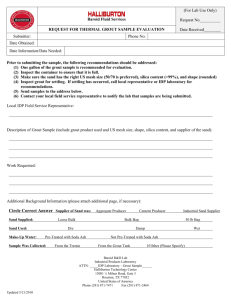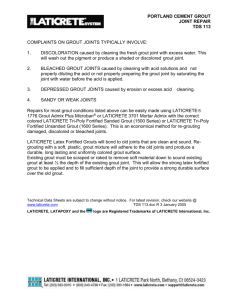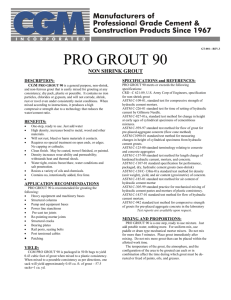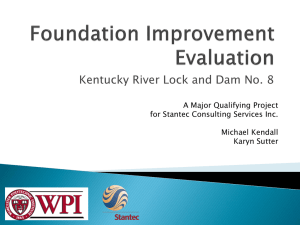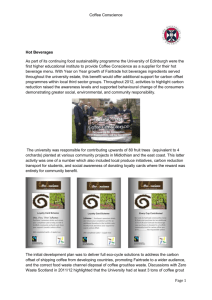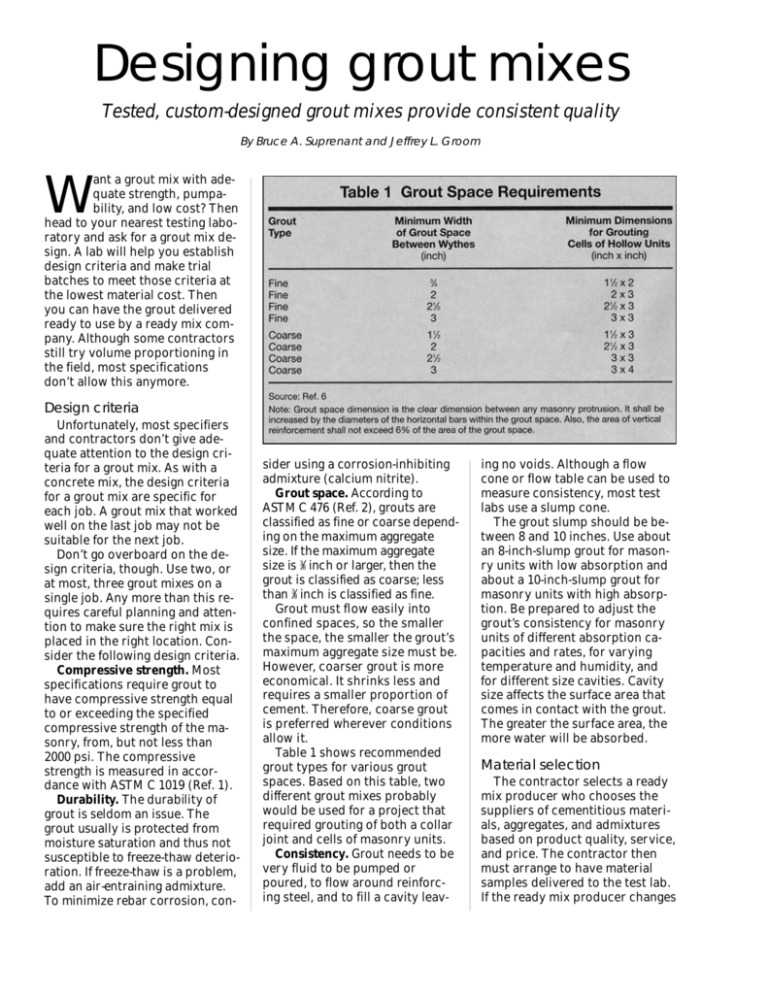
Designing grout mixes
Tested, custom-designed grout mixes provide consistent quality
By Bruce A. Suprenant and Jeffrey L. Groom
ant a grout mix with adequate strength, pumpability, and low cost? Then
head to your nearest testing laboratory and ask for a grout mix design. A lab will help you establish
design criteria and make trial
batches to meet those criteria at
the lowest material cost. Then
you can have the grout delivered
ready to use by a ready mix company. Although some contractors
still try volume proportioning in
the field, most specifications
don’t allow this anymore.
W
Design criteria
Unfortunately, most specifiers
and contractors don’t give adequate attention to the design criteria for a grout mix. As with a
concrete mix, the design criteria
for a grout mix are specific for
each job. A grout mix that worked
well on the last job may not be
suitable for the next job.
Don’t go overboard on the design criteria, though. Use two, or
at most, three grout mixes on a
single job. Any more than this requires careful planning and attention to make sure the right mix is
placed in the right location. Consider the following design criteria.
Compressive strength. Most
specifications require grout to
have compressive strength equal
to or exceeding the specified
compressive strength of the masonry, from, but not less than
2000 psi. The compressive
strength is measured in accordance with ASTM C 1019 (Ref. 1).
Durability. The durability of
grout is seldom an issue. The
grout usually is protected from
moisture saturation and thus not
susceptible to freeze-thaw deterioration. If freeze-thaw is a problem,
add an air-entraining admixture.
To minimize rebar corrosion, con-
sider using a corrosion-inhibiting
admixture (calcium nitrite).
Grout space. According to
ASTM C 476 (Ref. 2), grouts are
classified as fine or coarse depending on the maximum aggregate
size. If the maximum aggregate
size is 3⁄8 inch or larger, then the
grout is classified as coarse; less
than 3⁄8 inch is classified as fine.
Grout must flow easily into
confined spaces, so the smaller
the space, the smaller the grout’s
maximum aggregate size must be.
However, coarser grout is more
economical. It shrinks less and
requires a smaller proportion of
cement. Therefore, coarse grout
is preferred wherever conditions
allow it.
Table 1 shows recommended
grout types for various grout
spaces. Based on this table, two
different grout mixes probably
would be used for a project that
required grouting of both a collar
joint and cells of masonry units.
Consistency. Grout needs to be
very fluid to be pumped or
poured, to flow around reinforcing steel, and to fill a cavity leav-
ing no voids. Although a flow
cone or flow table can be used to
measure consistency, most test
labs use a slump cone.
The grout slump should be between 8 and 10 inches. Use about
an 8-inch-slump grout for masonry units with low absorption and
about a 10-inch-slump grout for
masonry units with high absorption. Be prepared to adjust the
grout’s consistency for masonry
units of different absorption capacities and rates, for varying
temperature and humidity, and
for different size cavities. Cavity
size affects the surface area that
comes in contact with the grout.
The greater the surface area, the
more water will be absorbed.
Material selection
The contractor selects a ready
mix producer who chooses the
suppliers of cementitious materials, aggregates, and admixtures
based on product quality, service,
and price. The contractor then
must arrange to have material
samples delivered to the test lab.
If the ready mix producer changes
material suppliers during the
project, then a mix design should
be made with any new materials.
The test lab, if necessary, can
check each product to make sure
it conforms to ASTM standards.
Cementitious materials. Use
portland cement meeting ASTM C
150 (Ref. 3) or blended cements
meeting ASTM C 595 (Ref. 4). Almost all masonry grouts contain
fly ash as a partial replacement
for portland cement. Fly ash contributes strength, acts as a waterreducer, and costs less than cement. ASTM C 595 permits up to
40% fly ash by weight of the cementitious materials.
Aggregates. Aggregates used in
grout must conform to ASTM C
404 (Ref. 5). This standard defines
gradation for both fine and coarse
aggregate and sets limits on deleterious substances (lightweight
and friable particles), organic impurities, and soundness.
Although ASTM C 404 limits the
maximum aggregate size to 3⁄8 inch,
some engineers allow up to 3⁄4-inch
aggregate for grouting columns,
pilasters, or large voids. The larger aggregate takes up more volume, reduces grout shrinkage,
and requires less cement for
equivalent strength. Some grout
pumps, however, may not pump a
3
4⁄ -inch rock mix.
Admixtures. ASTM C 476
doesn’t allow the use of admixtures in grout unless specified by
the engineer or architect or approved by the contractor. Admixtures, however, can facilitate construction by accelerating grout set
in cold weather and retarding
grout set in hot weather. To maintain the water-cement ratios and
high strength, some engineers
specify a superplasticizer instead
of adding water to increase slump.
Shrinkage-compensating admixtures or grouting aids are the
most common grout admixture.
After placement, grout shrinks
from 5% to 10% as the surrounding masonry units absorb water
from the grout. To minimize this
volume loss, a shrinkage-compensating admixture may be added to
the truck mixer at the jobsite.
These blended admixtures expand the grout, retard its set, and
act as a water-reducer. This combination minimizes grout volume
loss and gives workers more time
to vibrate the grout before it stiffens. Table 2 shows the admixtures typically used for grouting,
their applications, and costs.
Trial batches
After the architect or engineer
sets the design criteria and the
contractor obtains the material
samples, the testing lab suggests
mix proportions that meet the design criteria. Then the lab makes
trial batches to determine the
most economical grout mix. ASTM
C 476 serves only as a rough
guide to mix design. It expresses
proportions in ranges to account
for material differences throughout the United States. The test lab
bases its trial mix proportions on
experience.
Though ASTM C 476 lists grout
proportions by volume (Table 3),
most specifications don’t allow
batching of grout by volume in
the field. Today, test labs and
ready mix companies batch by
weight. Volume proportions can
be changed to equivalent weight
proportions (pounds per cubic
yard) by using the specific gravity
of each ingredient.
Don’t experiment
at the jobsite
A mix design that uses three trial batches costs from $800 to
$1,200. Some contractors try to
avoid a mix design to save $1,000,
but they often pay for it later with
a grout that has low strength and
doesn’t pump. One ready mix supplier tried volume proportioning a
grout mix in accordance with
ASTM C 476 but found that the mix
segregated when pumped. Don’t
try to design a mix at the site; pay
a test laboratory for a mix design.
You’ll sleep a lot better.
Bruce A. Suprenant is a consulting engineer
and adjunct associate professor at the University of Colorado at Boulder. Jeffrey L.
Groom is a senior engineer at CTL/Thompson, a materials engineering and testing laboratory in Denver.
Race St., Philadelphia, PA 19103.
2. ASTM C 476, Standard Specification for
Grout for Masonry, ASTM.
3. ASTM C 150, Standard Specification for
Portland Cement, ASTM.
References
4. ASTM C 595, Standard Specification for
Blended Cements, ASTM.
1. ASTM C 1019, Standard Method of
Sampling and Testing Grout, ASTM, 1916
5. ASTM C 404, Standard Specification for
Aggregates for Masonry Grout, ASTM.
A Mix Design Example
A ready mix company requests
a grout mix for filling block cells.
The design criteria are: minimum
2500-psi compressive strength at
28 days, 8-inch slump, 580 to
700 pounds of cementitious materials, 40% fly ash replacement
of total cementitious materials,
and total entrapped air from
0.5% to 1.0%.
The ready mix company submits these materials for use:
Type I-II portland cement,
Class C fly ash, sand meeting
gradation re q u i rements of Size
No. 1, and coarse aggre g a t e
meeting gradation re q u i rements of Size No. 8.
The test lab mixes and evaluates three trial batches (Table 1).
All three mixes meet the design
criteria. However, the lab recommends a compressive strength
overdesign of 1200 psi. (Although
overdesign is required for concrete mixes, no standards have
been established yet for grout.)
So now the grout must
achieve at least 3700 psi. Tr i a l
Batches 2 and 3 exceed this
s t rength; Trial Batch 1 does
not. To determine the minimum amount of cementitious
materials (the most costly ing redient) needed to achieve
3700 psi, the strengths of the
trial batches are plotted
against their cementitious contents on a graph (Figure 1).
Based on the resulting curv e ,
the lab determines that at least
625 pounds of cementitious
material are needed to re a c h
3700 psi. It thus re c o m m e n d s
the mix described in Table 2.
6. ACI 530.1/ASCE 6, Specifications for
Masonry Structures, American Concrete Institute, P.O. Box 19150, Detroit, Ml 48219.
PUBLICATION #M910218
Copyright 1991
The Aberdeen Group
All rights reserved

